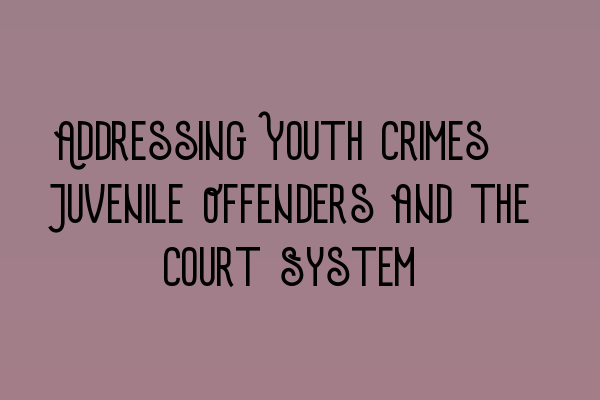Addressing Youth Crimes: Juvenile Offenders and the Court System
Introduction:
Youth crimes are a pressing issue that demands attention and effective strategies to address. In the United Kingdom, juvenile offenders are handled differently than adult criminals, recognizing that young individuals may require specialized rehabilitative approaches. This article will explore the court system’s role in addressing youth crimes, highlighting both the challenges faced and the potential solutions available.
The Unique Nature of Juvenile Offenders:
Juvenile offenders, often classified as individuals between the ages of 10 and 18, exhibit a distinct set of characteristics that differentiates them from adult criminals. These characteristics include immature decision-making abilities, susceptibility to peer influence, and a higher likelihood of being influenced by external factors such as family or community environments.
It is important to approach juvenile offenders with an understanding of their unique circumstances. Recognizing that they are in a crucial phase of development, the court system aims to rehabilitate rather than solely punish young offenders. By doing so, it aims to prevent them from becoming lifelong criminals and instead reintegrate them into society as law-abiding citizens.
The Role of the Court System:
The court system plays a vital role in addressing youth crimes. It seeks to strike a delicate balance between holding juvenile offenders accountable for their actions and providing them with opportunities for rehabilitation and growth. The focus is on restorative justice, which aims to repair the harm caused by the offense and address the underlying issues that led to the criminal behavior.
Juvenile Courts:
Juvenile offenders are brought before specialized courts known as juvenile courts. These courts employ strategies tailored to the needs of young individuals, taking into account their age, maturity level, and personal circumstances. The proceedings are less formal than adult court proceedings, with a greater emphasis on guidance, education, and support.
In juvenile courts, an offender may be subject to a range of measures, including probation supervision, community service, counseling, and educational programs. The court aims to rehabilitate the offender and provide them with the necessary skills and support to reintegrate successfully into society.
Alternative Dispute Resolution:
For less serious offenses committed by juvenile offenders, alternative dispute resolution methods may be employed. These methods, such as mediation or restorative justice practices, encourage dialogue between the offender, victim, and affected parties. The aim is to repair the harm caused, promote understanding, and prevent reoffending.
Alternative dispute resolution methods can be highly effective in addressing youth crimes as they allow for a more personalized approach that takes into consideration the unique circumstances of each case. They foster empathy, accountability, and may lead to more meaningful outcomes for all involved parties.
Challenges and Solutions:
While the court system’s approach to addressing youth crimes is commendable, it is not without its challenges. Limited resources, overburdened caseloads, and the need to balance public safety with rehabilitation all pose significant hurdles. However, innovative solutions are continuously being explored to overcome these obstacles and improve outcomes for juvenile offenders.
One such solution is the implementation of diversion programs. These programs aim to divert young offenders away from the court system and into community-based initiatives focused on addressing the underlying causes of their behavior. Diversion programs offer counseling, mentoring, and skill-building opportunities to support the offender in making positive life choices.
Additionally, collaboration between the court system, social services, schools, and community organizations is crucial in providing comprehensive support to juvenile offenders. By working together, these entities can identify early signs of potential criminal behavior and intervene before situations escalate.
Conclusion:
Addressing youth crimes requires a multifaceted approach that acknowledges the unique nature of juvenile offenders. The court system plays a pivotal role in rehabilitating young individuals, integrating restorative justice principles, and exploring alternative dispute resolution methods. While challenges persist, innovative solutions and collaborative efforts offer hope for a brighter future where young offenders are given the support they need to become productive members of society.
Related Articles:
